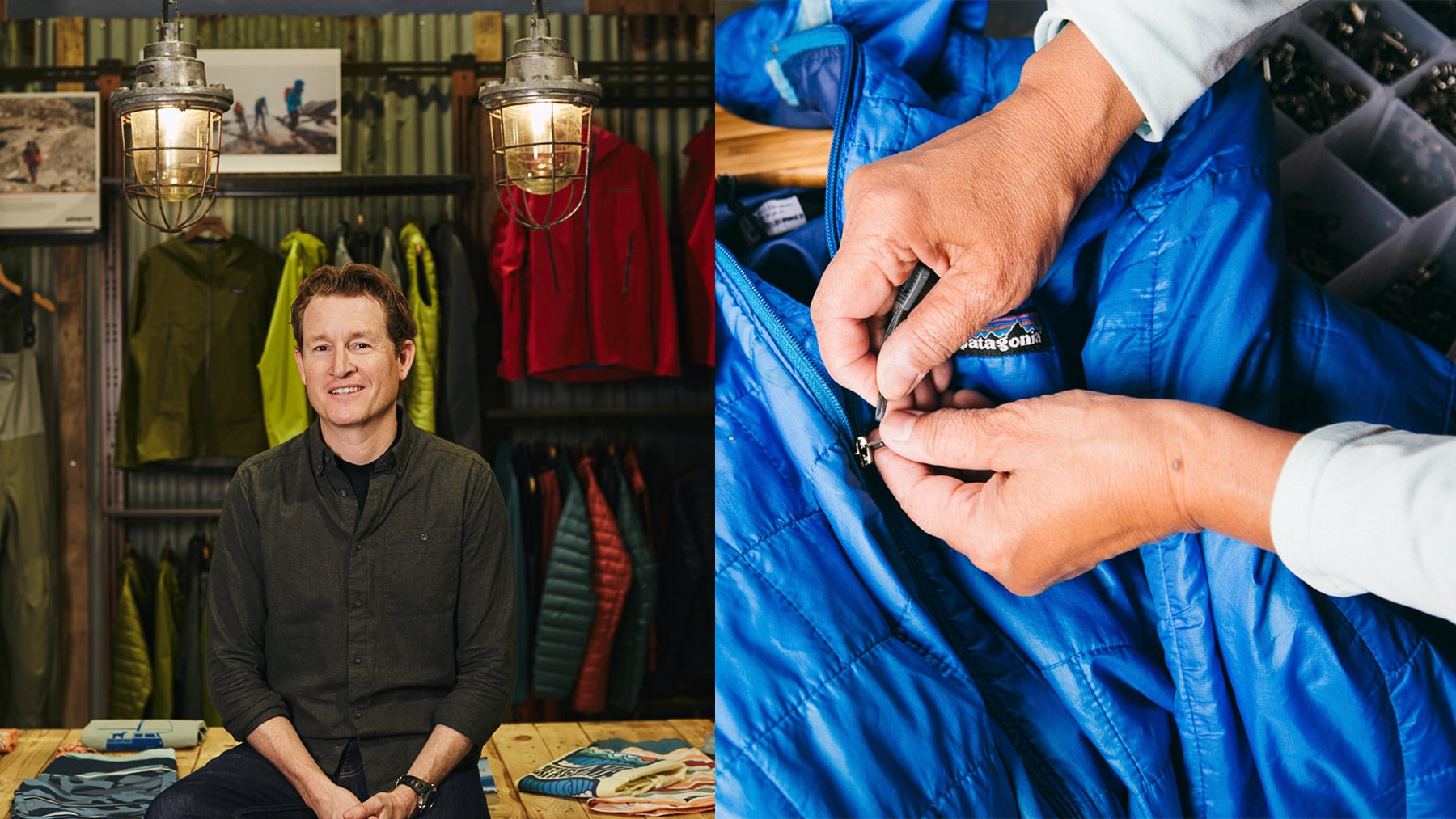
COPENHAGEN, Denmark — Patagonia CEO Ryan Gellert has been mulling a peculiar problem for a top executive at a billion-dollar brand: Can a business be successful if it’s not growing?
While it’s become fashionable for business leaders to talk about “stakeholder capitalism” — the notion that businesses should be oriented to serve society as a whole — shareholder supremacy remains a dominant principle in the vast majority of boardrooms, meaning companies are primarily measured on how much money they can return to investors and whether this number is increasing every year. For fashion, that generally means selling more stuff to more people, more often.
This “more is more” model has proved wildly successful, spawning a multi-trillion-dollar industry led by some of the world’s wealthiest families, from LVMH’s Arnaults to Zara-owner Inditex’s Ortegas. It’s also fueled excess consumption and the rise of an environmentally destructive system of overproduction that sucks up natural resources and spews out pollution.
This has always been a source of tension for Patagonia. For more than half a century, the outerwear business founded by rock climber and environmentalist Yvon Chouinard has cast itself as a live-action case study in “conscious capitalism.” It’s stated aim: to prove companies can balance profit with purpose.
Sales that hit $1.5 billion in 2022 have enabled the business to donate more than $200 million over the years through its One Percent for the Planet programme, which devotes one percent of each year’s sales to causes that protect and restore the environment. Chouinard took this to a new level in 2022, when he made “earth” the company’s “only shareholder.” The business is now nearly wholly owned by a nonprofit whose mandate is to use any earnings not reinvested in the company — some $50 million in 2022 — to protect the environment and fight climate change.
There’s a tension around growth … the biggest magic trick in business [is figuring out how to] be impactful and ascendant while standing still.
That puts Gellert, who became chief executive in September 2020, in charge of running a business that is something of a paradox: While its profits are intended to preserve and protect its biggest stakeholder, the planet, its means of generating them — making and selling more stuff — do exactly the opposite.
“There’s a tension around growth, and certainly around growth for growth’s sake,” Gellert said during a recent interview in Copenhagen, where he was due to attend the Global Fashion Summit, an annual industry conference focused on sustainability. “The biggest magic trick in business [is figuring out how to] be impactful and ascendant while standing still.”
That doesn’t mean the company wants to shrink. Though this line of thinking flirts with some of the ideas put forward by the increasingly trendy anti-capitalist degrowth movement, there’s no “let’s get smaller mandate,” Gellert hastened to add. But growth, at least as a function of selling more new products, is simply not going to be at the top of the executive’s agenda.
The ‘Biggest Magic Trick’ in Business
Exactly how Gellert plans to balance these competing priorities is still a little murky. “Resale is top of the list for me,” he said. “At scale, I would like to really make it a central part of the business.”
That’s a bold bet on a complex model that has proved challenging to operate profitably and has yet to demonstrate its environmental benefit; the rapid rise of third-party and branded resale initiatives in recent years has so far done nothing to diminish the production and consumption of new products. In some circles, it’s even been pitched as a way to attract first-time consumers to a brand and encourage them to make “investment” purchases they know they can later flip.
Patagonia’s resale programme, Worn Wear, has been around longer than most and has always been linked to the brand’s long-standing messaging encouraging consumers to buy less. It launched in 2013, with the addition of used clothing sections in select stores. In 2014, the company invested in resale-as-a-service platform Trove, debuting its own re-commerce offering three years later.
Today, it offers thousands of pre-owned Patagonia fleeces, jackets and flannels at a neat discount to new gear. Consumers are incentivised to sell back their old Patagonia products for up to 50 percent of the retail price in store credit, while shoppers on the company’s main site get a prompt to browse used when they click to buy a new garment.
Unlike repair, which Gellert described as a “complete cost centre” with “karmic value,” the resale business is profitable and growing. But the CEO acknowledged it’s still a “tiny” slice of Patagonia’s overall business. A Reuters report last year pegged it at just $5 million, or less than 1 percent of the company’s total sales.
Gellert doesn’t want to be pinned down on exactly what proportion of the business secondary sales might ultimately become, or when. The company said it’s still a work in progress.
“We’ve worked through the small problems,” said Gellert. (These include shifting the company’s cotton supply to organic and ratcheting up its use of recycled materials and Fairtrade-certified suppliers). “We’re now at the bigger problems. Repair was a bold step. Resale is the next frontier.”
Curbing Consumption
But even if Patagonia never made another new product, a wholesale shift to secondhand would only ever be a drop in the vast expanse of fashion consumption. That’s why Gellert is as interested in what his company can do to influence the way people shop as he is in changing the way it operates.
“The single biggest question,” he said, “is how does a company in the consumer goods space, that makes stuff people want but don’t need to survive, influence consumption?”
That’s as tricky as it sounds.
Though the CEO said the company is “not in the business of telling people not to buy our stuff,” it has, in fact, told them to do just that. It famously took out a full-page ad in The New York Times for Black Friday in 2011, showing an image of one of its fleeces under the strapline “Don’t buy this jacket.” The upshot: It sold more jackets.
Last month it released “The Shitthropocene,” a 45-minute mockumentary that was part educational PSA, part marketing. The title was a tongue-in-cheek nod to the Anthropocene — a term commonly used to describe the era in which humans have had a significant impact on the planet. The rise of fast fashion and overconsumption, for their part, have resulted in an age “characterised by things that are shitty,” the film’s narrator explains as it opens.
The humour, which took aim at Patagonia as well as the industry at large, was intended to address a frequently cited problem with brands’ sustainability messaging: It’s often boring, preachy and forgettable. But for some pundits, the film landed flat, reading like performative and promotional virtue signalling.
“There was plenty of criticism,” Gellert acknowledged. What cut deepest was the sense some viewers took away that Patagonia was positioning itself above the issues plaguing the rest of the industry. In Gellert’s view, the company’s never tried to suggest it doesn’t get things wrong. It’s just constantly trying to get more right.
The executive’s favourite saying — one he’s quoted often enough to generate eye rolls whenever it gets repeated internally — is that the reward in life for solving a problem is a bigger problem.
The Patagonia Paradox
Some of the problems facing Patagonia aren’t just big, they’re seemingly intractable.
The company campaigns against oil pipelines while making jackets out of plastic; its anti-consumption messaging often results in more sales; and its path to new business models is uncertain.
It has been vocally critical of big businesses that advocate for more climate-friendly policies while remaining members of lobby groups that are campaigning against them. This is an issue the company has largely managed to sidestep itself, because until recently fashion has faced so little regulatory scrutiny. But it’s becoming a more live consideration. Patagonia sits on the American Apparel and Footwear Association’s working group on the New York Fashion Act, a landmark piece of fashion-focused sustainability regulation that the company has publicly endorsed, but that the AAFA says pushes too far, too fast.
The single biggest impact we’ve had … is modelling a more progressive version of a business and proving it can be ascendant. I think that’s made a little dent.
Navigating such contradictions is becoming increasingly complex and increasingly fraught. Solutions, such as exist, are invariably imperfect in a world that is ever more polarised. Increasingly savvy consumers are also more critical of sustainability messaging they view as inauthentic or lacking credibility. In the US in particular, corporate climate action has become a political issue, with Republican politicians taking aim at so-called “woke capitalism” — a movement for which Patagonia is one of the most prominent poster children — ahead of elections in November.
“I don’t think people can be too cynical about what they hear from business,” Gellert said, acknowledging that all the efforts Patagonia makes to align its values and its business operations come with trade-offs and new challenges.
The company has said it remains supportive of The New York Fashion Act but shares some of the AAFA’s concerns about the bill to ensure consistency in environmental reporting requirements. How that shakes out is likely to become clearer next year, since the New York legislative session ended in June with the proposed legislation still pending. A compromise on the bill wouldn’t necessarily be a “divorce-level conversation,” Gellert said.
When it comes to plastic, the company is aiming to only use recycled polyester by next year, a move that’s more of an improvement than a solution. At present, most recycled polyester in the world comes from plastic bottles, which means it does nothing to tackle textile waste and instead turns items that could be recycled multiple times into fabrics that are likely to wind up in landfill. Patagonia is eyeing opportunities in textile-to-textile recycling, but innovations in this space have yet to reach commercial scale. It’s also invested in research to address microplastic pollution. The tiny plastic particles that shed from many of the synthetic fabrics Patagonia and other fashion brands use have been found everywhere, but represent yet another challenge without a clear, satisfactory solution.
Ultimately it comes down to quality and durability for Gellert. “It’s too simplistic an argument that all organic is good and all plastic is bad; we are a technical outdoor apparel company and we want to build the best product,” he said. “How do we balance that? It’s hard to imagine a world where synthetics are not a part of what we do and also one where virgin synthetics are any part of it.”
A fresher issue is the industry-wide downturn buffeting Patagonia’s bottom line. Its last financial year, which ended in April, was “tricky” Gellert said. But with no banks or financial investors breathing down his neck, the CEO said he has the freedom to think more long-term than most competitors. He’s trimmed the company’s marketing budget and slowed hiring to help navigate the sluggish environment, rather than pulling back on sustainability initiatives.
Over the years, those have consistently put Patagonia at the forefront of efforts to craft a more climate-friendly form of capitalism. “[The company] is an authentic sustainability paragon,” said Ken Pucker, professor of the practice at the Fletcher School at Tufts University. “At the same time, any business that’s a multiple of its size a decade ago is going to have a nastier environmental footprint.”
Perhaps the easiest way to understand Patagonia’s position is to take its mission statement on face value. The company is “in business to save the planet.” It’s conscious capitalism tinged with Realpolitik; not profit at any cost, but there must still be profit.
“The single biggest impact we’ve had … is modelling a more progressive version of a business and proving it can be ascendant,” said Gellert. “I think that’s made a little dent.”



